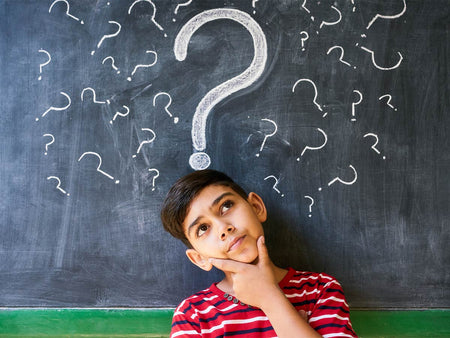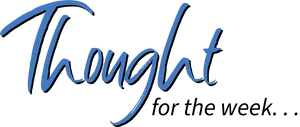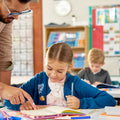Latest Posts

In Your Corner, Student Learning
Virtual Reality in Education: Coming Sooner Than We Think?
Is virtual reality the next big wave in education? In some form, virtual reality has been around for a long time. However, many advocates believe that its time is coming and it has the potential to transform many aspects of how students experience learning.
Virtual reality (VR) is typically defined as a computer-generated experience that immerses participants in what feels like reality. It has the potential to generate the experience of being in any place or circumstance in the world and beyond, without the expense and risk of being there. Students can travel under the ocean, scale the most rugged mountains, or experience the inside of the digestive system. While education-focused content for VR systems has lagged, change may be coming.
Many experts believe this trend may be about to accelerate. Recent research using VR in the development of skills in the business world has shown significant impacts on learning. For example, a recent study by PwC Labs, a developer and provider of integrated technology for business, demonstrated dramatic learning results. Participants in VR simulation-based training learned at a rate four times faster than classroom-based learners. Meanwhile, lessons lasted a mere twenty minutes versus the hour-long lessons common in traditional settings. Additionally, the study showed learning retention rates exceeding traditional training approaches by more than 75%!
Meanwhile, investments in global eLearning are anticipated to grow from $185.26 billion in 2020 to $388.23 billion in 2026. Of course, investments in eLearning, including VR, will lag in the education market since the immediate return on investment is not as great as in the industrial learning world. Nevertheless, the investment opportunity present in the post-COVID-19 education market will likely not be ignored for long, especially if the VR learning impact can be replicated in the K-12 and higher education environment.
The pandemic has increased educator awareness of technology’s potential to support learning. However, to date, technology in education has largely been confined to delivering instruction in much the way it was presented without technology. Consequently, the impact has been uneven at best.
What might we discover if we were to set aside the traditional instruction-driven learning model and ask how best to stimulate and nurture learning in our students? Might we discover new learning paths and strategies to build the knowledge and skills our students need to acquire? What potential might VR offer to assist our efforts?
It seems that at the very least, we need to learn as much as we can about the nature and potential of VR and other forms of eLearning to support our young people. We need to avoid the trap of concluding that the often clumsy and halting efforts at virtual learning from the pandemic are indicative of what is possible.
In his book Disrupting Class more than a decade ago, Clayton Christensen cautioned that almost all transformative innovations begin on the fringes of practice and are usually not very good. However, over time they become more stable, more impactful, and easier to manage. Eventually the innovation proves itself and becomes the dominant approach.
It is worth considering whether virtual reality may have the pervasive impact on our profession and practices that it is beginning to demonstrate in a business environment. Now is a good time to look beyond the challenges of the past two years and learn all we can about the potential of eLearning to transform the experience of our learners. It could be an amazing adventure!
The Research:
Kern, M. A. (n.d.). How the metaverse can supercharge corporate skills training. Agadir-Group. https://agadir-group.com/how-the-metaverse-can-supercharge-corporate-skills-training/
PwC. (n.d.). How virtual reality is redefining soft skills training. https://www.pwc.com/us/en/tech-effect/emerging-tech/virtual-reality-study.html

In Your Corner, Student Learning
College Remediation: Who’s at Fault and How to Prevent It
A disappointingly high number of college freshmen are required to take remedial mathematics and English courses as they begin their college careers. Pre-pandemic statistics indicate that as many as one in five high school graduates enrolling in four-year institutions must take at least one remedial course. Predictably, the challenge will grow in the aftermath of the disruption caused by COVID.
On its face, this information implies that these students have not received an adequate education in elementary, middle, and high school, or at least their preparation has not been sufficient for immediate success in college. Further, most college remedial courses require students to pay tuition, but the students receive no credit toward graduation. Consequently, students can find themselves falling deeper into debt before they even begin their path toward graduation. Studies also show that students who are required to take remedial courses are less likely to graduate with a degree, and if they do graduate, they are less likely to earn degrees that lead to higher compensated careers.
While it might be tempting to blame the high schools students attended, the situation might be more complicated than it initially appears. In fact, several forces are likely contributing to the problem, and they deserve scrutiny.
Students and families hear the message that college is a crucial part of the path to career success. The expectation has led to an increasing number of students enrolling in college, even when they have no strong interest in or commitment to attending. For many, college feels like the next educational step, and family expectations and aspirations feed this perception. Consequently, many students enter college without having made a commitment to the academic learning that will prepare them for success. This argument is not intended to place full blame on the students. Rather, it is recognition that the drive necessary to prepare for and succeed in higher education is often not present for several societal, community, familial, and personal reasons.
Of course, high schools share responsibility if they fail to help students understand the expectations and level of learning effort necessary for success in college. However, high schools face pressure to send as many students to college as possible since such data is often used as a proxy to signify the academic challenge and success of the school. This pressure can lead to encouragement for college enrollment even when students’ current performance makes college a risky choice. Meanwhile, the academic expectations and skill levels necessary for college success are not secret. Higher education institutions are typically eager to share information regarding the skills necessary for success at the college level. Sharing this information with students early in their secondary school careers might help them adjust their current learning efforts and inform decisions about post high school pursuits.
Institutions of higher education also need to share responsibility for this situation. The state of student academic preparation is not difficult to ascertain. In fact, this information is presumably part of the decision-making process used to assign students to remedial classes.
It is also true that higher education institutions face pressures that may influence their attention and decision-making. Students provide revenue. The more students who enroll, the more revenue they generate. Further, remedial courses generate revenue without having to grant credits. Since students who have to enroll in remedial courses often exit college early, the revenue they generate can presumably be reallocated to support more advanced students in programs that enroll fewer students and are more expensive to offer.
The challenge of academic remediation in higher education is important and must be addressed, but we need to be thoughtful about the approach. In fact, it appears to be a system problem, and system problems almost always require engagement from multiple stakeholders and perspectives to find effective, responsible solutions. It is time for higher education and secondary education to do more than point fingers. Students’ lives and futures are at stake. This problem can be solved, but it will require courage and leadership from all who play a role.
Share Your Tips & Stories
Share your story and the tips you have for getting through this challenging time. It can remind a fellow school leader of something they forgot, or your example can make a difficult task much easier and allow them to get more done in less time. We may publish your comments.
Send Us An Email













